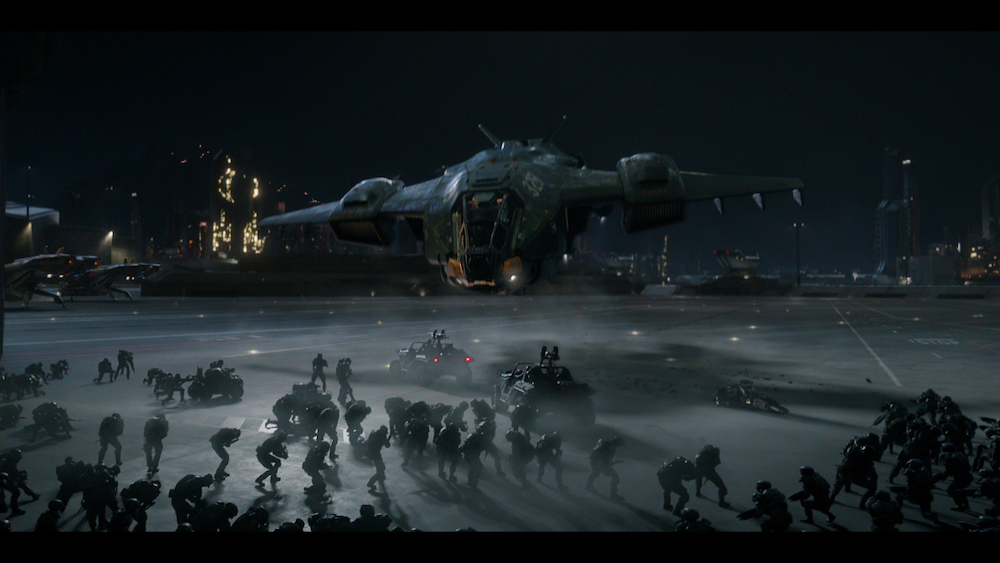Your appreciation of the long-awaited video game adaptation may hinge on the question: “How many murdered children is too many?”
Screening two episodes of any series that’s more than, let’s say, four episodes leaves a lot to the imagination. Introductions can lay the groundwork, but the winding path reaches far into distance. Still, with a project this long-in-the-works (development started nearly a decade ago) of a franchise this popular (the Xbox video games have made more than $6 billion) that’s already the face of a major media conglomerate’s year-old streaming platform, “Halo” isn’t built to sneak up on anyone. It’s been engineered to arrive with a bang, from its SXSW festival debut Monday night to Master Chief’s heaven-sent star turn in the premiere.
Given all that hype, it should come as little surprise the first two hours (of the nine-hour first season) elicit immediate comparisons to two of TV’s most successful recent programs: “Halo” enlists the stark violence of “Game of Thrones,” while hinting at similar political scheming amid an ongoing war, while its A-plot follows “The Mandalorian” model: a masked, stoic, emotionally stunted warrior questions his creed when asked to sell out an innocent child. Allusions to the video game are layered in for fans, via first-person shooter camera angles and nods to franchise lore, while the visual effects carry the shimmering gleam of big-budget science-fiction.
In other words, it’s exactly what you expect. While “Halo” features a few minor pivots in these early hours, there’s very little to spoil and even less to spark curiosity that’s not already present.
Perhaps most surprising is how smoothly the initial narrative plays out, given how many creatives came and went during development. Directed by Otto Bathurst and written by co-showrunners Kyle Killen and Steven Kane, the series picks up in the year 2552 on “Tier 4 Heavy Water Extraction Planet” (Madrigal for short) and wastes no time getting to its top priority: turning Master Chief into a G.D. legend. It first does this by visiting a local watering hole and listening to human soldiers tell stories about Spartans: genetically engineered super-soldiers fighting on behalf of the United Nations Space Command. “Spartans aren’t human,” says a gray-haired man holding court while playing cards. “They’re faster, stronger, smarter — they cannot be stopped. They just keep on killing, without mercy, until there’s nothing left to kill.”

Pablo Schreiber in “Halo”
Paramount+
The people of Madrigal value their independence, rather than being ruled by the UNSC, so when their colony base comes under attack, the first assumption is, “Oh shit. Spartans!” But it’s not man nor super-soldier who comes blasting through their gate but a more peculiar hyphenate: giant man-lizards with jaws like a spider and spiky arms touting laser swords. Like viewers, the locals have no idea what they are or why they’re murdering everyone in sight, but their force-field body armor certainly gives the illusion of invincibility and they do, in fact, appear determined to kill everyone in sight. Most deaths are notably violent. Limbs are blasted off in bloody spurts. Bodies are sliced into pieces. A young man pleading for help is stabbed in the back. The 12-minute battle scene begins and ends with separate groups of children being eviscerated by gunfire. Make no illusion: “Halo” isn’t an all-ages affair.
But kids aren’t just used to emphasize “Halo’s” ruthless self-seriousness; they’re also, somehow, a moral turning point. After the Spartans arrive on scene — dropping from the sky with a walloping thud and guns loaded with alien-killing ammunition — Master Chief Petty Officer John-117 (Pablo Schreiber, whose voice work is a premiere highlight) investigates why the aliens (known as “the Covenant”) were there in the first place. Turns out there’s some sort of artifact buried deep within the mountains of Madrigal. When “John” grabs hold, it emits a powerful energy surge and elicits suppressed memories from Master Chief’s past. Suddenly, rather than following orders at all costs, he’s breaking protocol to travel alone and shutting off communication systems with his bosses back at UNSC — all to protect a young girl named Kwan (Yerin Ha) who, before touching the artifact, he was fine leaving behind to die.
Soon enough, UNSC leaders are spooked by a rule-breaking super-soldier, and John’s actions escalate tensions among space politicos. Various authority figures want him taken out of commission, but Dr. Catherine Halsey (Natascha McElhone) defends her creation. He’s a major military asset. The war between the Covenant and the UNSC has been going on for years, and they’re no sooner to defeating the alien armies than they are understanding what they want. John, along with the artifact he’s carrying, is key to doing both. The girl he’s protecting may not matter to them, but she matters to John — he just has to figure out why…



“Halo”
Paramount+
The second hour starts to get into it, flashing back 20 years to a pivotal moment in John’s past that doubles as blunt foreshadowing for where he’ll go next. The episode is absent the action pieces that dominate the premiere, setting up relationships and rivalries within the UNSC and Covenant alike. Discussions graze on long-standing military ethical issues like, “Who’s better equipped to make decisions: soldiers with boots on the ground, or generals looking at the big picture?” and “What’s the point in saving humanity if we’re going to give up our own?” And if you guessed the latter was a direct quote, winner winner, as the query also serves as Master Chief’s guiding dilemma. Can a killing machine preserve safe societies spread across a galaxy, or is it simply a tool to win wars? Can human nature be stripped from a person with “pellets” (part of any good super-soldier’s diet), or is there always an intrinsic sense of right and wrong? Can “Halo” find nuance in these answers to better elucidate the good vs. evil action series it sets up?
If these questions sound promising to you (or broad enough to ignore while you watch the flashing lights), then “Halo” should be a smooth enough ride, at least for a while. Schreiber is a talent worth seeing sans helmet (and he does go the majority of Episode 2 without it). McElhone can dance along the line between caring matriarch and cold-blooded scientist. The action feels more like watching kids play with their toys than slickly choreographed cinema, but the money invested in this massive production is certainly up on screen. “Halo” may very well evolve into something more than a math equation (“Game of Thrones” + “The Mandalorian” = “Halo”). What’s unclear is whether Paramount+ actually wants it to, or if these obvious comparisons are precisely the point.
Grade: C+
“Halo” premiered at the 2022 SXSW Festival. Paramount+ will release the first episode Thursday, March 24. New episodes will be released weekly.
Sign Up: Stay on top of the latest breaking film and TV news! Sign up for our Email Newsletters here.




















![[Book Review] The Blade Itself (The First Law Trilogy) by Joe Abercrombie](https://bendthekneegot.com/wp-content/uploads/2018/01/1516047103_maxresdefault-218x150.jpg)

















